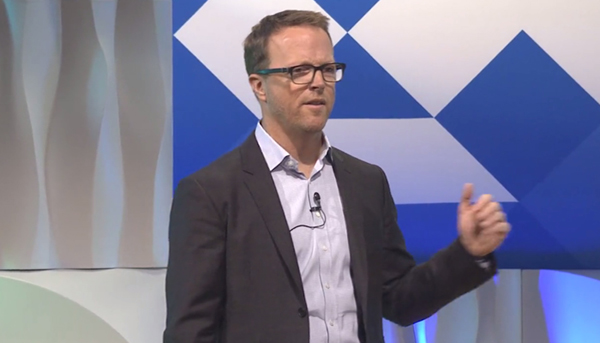Lending Club CEO sketches the future
Scott Sanborn points to new initiatives following tough 2016
- |
- Written by Bill Streeter
 Marketplace lender's new leader outlined three initiatives for the company's near-term future at LendIt USA recently.
Marketplace lender's new leader outlined three initiatives for the company's near-term future at LendIt USA recently.
The speech was cross between an annual meeting report, an investor presentation, and a sales pitch. When Lending Club CEO Scott Sanborn spoke at the LendIt USA Conference in March the majority of the audience represented a key part of Lending Club’s funding base—institutional investors, including banks—as well as potential partners and competitors in the marketplace lending community.
Some of the pointed questions that followed Sanborn’s presentation reflected this mix. For example:
What impact will rising rates have on Lending Club’s proposition for investors?
Sanborn responded that the historically low-rate environment helped the marketplace industry and specifically Lending Club “attract investors early on, even as we were establishing our track record.” In explaining how the company would maintain the attractiveness of the asset in a rising-rate environment, he pointed out that Lending Club competes primarily with credit cards.
“Roughly 60% of our loans are to people who are paying off existing credit card debt with a lower interest fixed-payment loan from us,” Sanborn said.
Credit card rates are set based on the prime rate, he continued. “Therefore, as rates go up it will be possible for us to maintain a spread. You’ve seen us raise rates over the last year and continue to have an attractive offering to borrowers,” said Sanborn. “On average borrowers are telling us they’re saving about 25% versus their credit cards so it’s a pretty material spread there that we’re comfortable with.”
He also observed that many of Lending Club’s investors, but especially banks and asset managers who have dedicated funds to marketplace lending, are not traders.
“These are long-term investors,” Sanborn explained.
Views on fintech charter
Also interesting was Sanborn’s response to a question about Lending Club’s interest in the national “fintech charter” proposed by the Office of the Comptroller of the Currency.
“At a high level we’re super excited to see the engagement of the OCC,” he said, because it recognizes the growth of the marketplace lending industry. He also said that, “We’re happy we’ve got a regulatory structure that works for us today, partnering with an issuing bank [WebBank, Salt Lake City].”
Nevertheless he said Lending Club will be interested to explore what the OCC charter contains but that it’s too soon to say if Lending Club will use it.
One factor he didn’t mention is whether the trend of several states (Colorado being a recent one) using courts to enforce their usury laws against nonbank lenders might factor into the company’s decision.
Tough year for online lenders
Sanborn graduated to the CEO position at Lending Club last June, after founder Renaud Laplanche resigned abruptly over allegations of falsified loan-sale information and other matters. Sanborn, who has been with the company since 2010, said at the conference that he was “excited to say goodbye to 2016. It was a tough year for online lending.”
Tough for Lending Club in particular, but also for the entire sector, which saw declining volume, steep losses, and layoffs, causing many to question the long-term viability of marketplace lending. Lending Club lost $146 million in 2016.
After recapping last year briefly, Sanborn said: “So what now? Do we take our ball and go home? No. The attendance at this year’s LendIt [@5,600] would tell us otherwise. 2016 was a stop along the way of what has been an incredible first decade.”
Marketplace lending's evolution appears to be following a path similar to that of the early days of ecommerce, suggested Lending Club CEO Scott Sanborn, speaking at the March LendIt USA conference. (Click here or on the image to view a video of his speech.)
Sanborn likened the situation to the online retail business, where he had worked earlier. The launch of eBay and Amazon in 1995 spawned a host of dotcom competitors, many of which went away. Amazon itself was expected to close doors, first in 1999 and then in 2001, he noted. Today the behemoth has $100 billion in e-commerce sales, with Walmart a distant second. Likewise, the development of the online lending business is not a linear process, said Sanborn, but more of a cycle.
Sanborn said the good news for 2016 that didn’t get a lot of press: “Lending Club remained the number one provider of personal loans in the country. We issued $8 billion in loans last year, bringing our total [outstandings] to $25 billion. SoFi was the number one provider of student loan refinancing—$4.5 billion issued last year—and OnDeck was the number one online provider of small business loans at $2.4 billion in loans issued last year.”
Three Lending Club initiatives
Sanborn spent the bulk of his speech describing three initiatives he sees shaping the online lending industry—and Lending Club—going forward.
1. Evolving the customer experience—Sanborn explored this area from the perspective of customers, investors, and the platform connecting the two.
• The customer. When Lending Club launched, said Sanborn, it disaggregated the typical credit application experience and delivered an instant offer with funds following a few days later if approved. That is now “table stakes,” he said.
“What’s next?” he continued. “One-click underwriting and [ability to] deliver loan approval and funding instantly is what we want to get to.”
• The investor. Sanborn said “most investors in this asset class right now are buy-and-hold investors of short duration, high-yield investments.” There is a secondary market, he added, but it’s mainly appropriate for retail investors transacting in small amounts.
Going forward: “How can we leverage blockchain/distributed ledger/smart contracts technology to enable investors to instantly transact amongst each other and move in and out of positions based on their own dynamics?”
• The platform. Lending Club is also exploring dynamic pricing.
“Four times a day we post loans and make them available for funding. We see that on certain loans dozens of investors are bidding on the loans, snapping them up in milliseconds,” said Sanborn, “there are other loans that [only] a handful of investors might purchase.” He said Lending Club incorporates this feedback and uses it to set pricing, but it’s a manual process.
Going forward: “How do we use machine learning to dynamically price loans and find the true market clearing price as these transactions are happening in real time and deliver the appropriate value to borrowers and investors?”
2. Unleashing the platform’s potential—Sanborn related how Amazon opened its customer base and delivery channel to other providers. These platform sellers now represent half of Amazon’s unit volume.
“In our industry,” said Sanborn, “several of us have added different products from the one we started with.” In Lending Club’s case these were small business loans and, last fall, auto loan refinancing.
“We’ve all built those products from soup to nuts,” said Sanborn. “Could we partner with other providers to provide their products to our customer base?”
He pointed out that there are 1.8 million borrowers using Lending Club, and there are other services these people need to manage their financial lives.
“Opening up the platform could allow us to provide better services,” said Sanborn.
Going a layer deeper, the Lending Club CEO said all of the steps in the credit process are distinct services, or “microservices.”
“Imagine a world where you can call on others [not just internally] to leverage decisions or pricing or servicing.” That would open up value to investors by allowing them to choose among different providers for different services—for example loan servicing on auto loans, which is critical in that niche—and the system is able to call out Lending Club or another provider.
“We control the customer experience, but you open up value to your investor by allowing them to choose,” Sanborn explained.
3. Amplifying core innovations—Referring to Amazon, again, and how it developed Amazon Web Services for itself and then opened it up to other fulfillment services, Sanborn asked: “How might our innovations be used outside the online lending business?”
An obvious one, he said, is partnering with other institutions. Examples include OnDeck working with JPMorgan for small business credit; Regions working with Avant; and Lending Club partnering with BancAlliance.
Beyond that, he said, some of the microservices mentioned above could generate value in other industries. One example is online verification—an area in which Lending Club specializes. The company guarantees investors against fraud losses from identity theft, Sanborn noted. As a result it has built capabilities to prevent ID theft. Since inception, he said, losses due to identity theft have been less than one basis point. He feels the company could offer that expertise to others or any other discreet services in the value chain.
Some interest in capital markets
Sanborn was also asked whether Lending Club would use the asset-backed securities market more in the future. Sanborn said Lending Club has historically made limited use of capital markets for funding. Its first foray was last year and the company saw high demand from a new group of investors.
He said Lending Club is committed to making asset-backed securities part of its funding mix going forward. He did emphasize “part of,” however, noting that the capital markets are fickle.
Regarding international expansion, Sanborn said it is a matter of “when,” not “if.” But he noted that the U.S. credit market in terms of its scale, consumer awareness, and a clear regulatory framework suggest the company’s near-term focus will continue to be in the U.S.
Future credit picture?
Finally, an audience member asked: How should we think about loss rates in a less-benign credit environment?
Sanborn responded that in a less-benign environment loss rates will rise.
“Our role is to manage that aggressively,” Sanborn said. He said Lending Club publishes the payment files of all of its publicly sold loans. “We’re looking at that data, our investor base is looking at that. So we have a very good feedback loop and manage according to that feedback.”
Sanborn noted that several times last year when they saw credit deterioration they took steps to cut credit issuance and to raise prices to increase the buffer for investors.
Tagged under Management, Lines of Business, Retail Banking, Technology, Channels, Fintech, Feature, Feature3,














